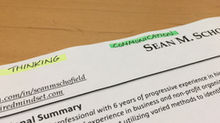The Social Media Blind-Spot
- Sean M. Schofield
- Jul 13, 2017
- 4 min read

There is a common misconception out there (especially in the age of social media) that what we do lasts only the 15 minutes or so that it appears in our various social feeds. As our content is pushed ever-further down, it escapes our minds and becomes a blind-spot in our past. It often shocks the students that I work with, when I discuss the permanence of what we do online, and the access that hiring managers have to our social content, even years into the future. In order to protect our image, our personal brand, it is critical to understand that there are not separate physical and digital worlds, but one world where our physical and digital presence are consistently interacting with one another. A world where information is more readily accessible than ever. When working with students, it MUST become routine practice to challenge student blind-spots and misconceptions, as digital actions have very real consequences.
High Competency Can Constrict Awareness
Have you ever parked your car after a drive home from work, only to realize that you don’t really recall a large portion of the ride? It’s an unnerving feeling, however, as our brains are processing data and scanning for important pieces of information, unremarkable information is often scrubbed to prevent saturation of our memory bank. This process helps us separate the important from the unimportant, and allows us to execute discreet tasks, without adding additional stress to our daily lives. We often call this “auto-pilot” or “muscle-memory,” and although this serves to protect us, it also has a tendency to minimize awareness. With technology at our fingertips, we manage a constant barrage of texts, emails, and messages, often putting communication on “auto-pilot.” It is common for college students to communicate virtually entirely through text-based messages, and to communicate in an efficient, minimalistic language. While members of Generation Z may hold digital, text-based forms of communication in high regard, I frequently hear members of older generations denouncing these methods of communication as professionally unacceptable. This rift has tarnished many relationships, and rather than argue for one side or another, it serves our students well to know that the divide is present, and can have an impact on perceptions of them. Remind students that you work with to take a moment to consider the person receiving a message before they send it, as some hiring managers are less approving than others of digital shorthand.
The Danger of Perceived Anonymity
The perception of anonymity has a remarkable influence on human actions. Disconnection between people in digital communications has been studied for over 35 years. In researching for this article, I came across a fascinating 1984 study by Kiesler, Siegel & McGuire that warned that computer-mediated communication frequently dehumanizes audiences, as people communicate digitally as if they are speaking with the machine rather than a reader. We see these dehumanizing effects empowering cyber-bullies and trolls in the comment sections of nearly all websites that offer a place for feedback. Being globally connected at all times paradoxically encourages us to feel incredibly small and geographically invulnerable, yet at the same time fills us with feelings of importance and reach. We frequently don’t think about the impact our statements have on our image, employability, and relationships in the physical realm. This leads to inauthenticity, which is toxic to our external image, our self-image, and corrodes any opportunity for interpersonal learning. As authenticity is highly regarded by Generation Z, check in with students you work with to see if they have taken the time to see the audience of their communication as people, honoring them as if they were standing directly in front of them.
We Lack Control of Our Digital Image
Similar to the concept of social-transparency discussed a moment ago, one element of social media that students often forget about is the lack of control that we have over what is posted about us, or what images of us live on the internet. While this is the most challenging aspect of our digital image to control, it is not any less important than the information we choose to share with others. Never before has there been so much access to information about each of us, blurring the lines between our personal and professional lives. One trick that students should become familiar with is the act of “Googling” themselves frequently. It may feel a bit narcissistic at first, however, performing simple internet searches of ourselves can alert us to potential issues that we may have to discuss when communicating with potential employers. Similar to checking your credit report, this is also a good way to see if any incorrect information is being published about you, which is the first step in contacting website managers to correct that information. As your students are likely spending a large amount of time on social media sites anyway, coax them into spending at least a portion of that time looking for unappealing information or imagery of themselves. It’s never too early to begin cleaning up our image and putting our best digital foot forward!
While we cannot control everything that is published or posted about us (ask any celebrity), there are simple steps to making sure that your digital image aligns with your personal and professional brand. Generating a positive social media presence is one of the best methods for making sure that appropriate LinkedIn or Facebook accounts are among the top Google search results for you. The right time to make yourself aware of any potentially negative press or imagery on the internet is BEFORE that big job interview, and always think about how you want your likeness to be portrayed for all the world to see.





![The Three Most Important Tools in the [Insert Role Here] Toolbox](https://static.wixstatic.com/media/95563e_ea80203fa49e4ce8973aad36dc9d82e0~mv2.png/v1/fill/w_447,h_250,fp_0.50_0.50,q_35,blur_30,enc_avif,quality_auto/95563e_ea80203fa49e4ce8973aad36dc9d82e0~mv2.webp)
![The Three Most Important Tools in the [Insert Role Here] Toolbox](https://static.wixstatic.com/media/95563e_ea80203fa49e4ce8973aad36dc9d82e0~mv2.png/v1/fill/w_220,h_123,fp_0.50_0.50,q_95,enc_avif,quality_auto/95563e_ea80203fa49e4ce8973aad36dc9d82e0~mv2.webp)
































Comments